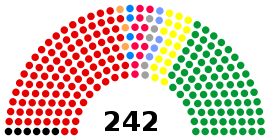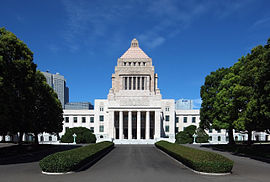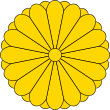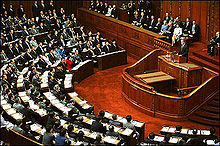- Diet of Japan
-
This article is about the Japanese legislature. For information on Japanese food, see Japanese cuisine."Kokkai" redirects here. For the Sumo wrestler from Georgia, see Kokkai Futoshi."The Diet" redirects here. For the Beetle Bailey animated short, see The Diet (cartoon).
National Diet
国会
KokkaiThe 177th Ordinary Session 
Type Type Bicameral Houses House of Representatives
House of CouncillorsLeadership Speaker of the Representatives Takahiro Yokomichi, DPJ
since September 16, 2009Speaker of the Councillors Takeo Nishioka, DPJ
since August 7, 2007Structure Members 722
480 (House of Representatives)
242 (House of Councillors)
House of
Representatives
Political groupsDPJ/Club of Independents (306)LDP (118)Kōmeitō (21)JCP (9)SDP/Shimin Rengō (6)YP (5)SPJ (2)former "Hiranuma group" (2)Independents (6)Vacant (1)
[1]
House of
Councillors
Political groupsDPJ/Shinryokufūkai (106)LDP (83)Kōmeitō (19)YP (11)JCP (6)SPJ/NRP (5)SDP (4)PNP (3)Independents (5)
[2]Elections House of
Representatives
Last election30 August 2009 (45th) House of
Councillors
Last election11 July 2010 (22nd) Meeting place 
National Diet Building, Nagatachō, Chiyoda-ku, Tokyo Website House of Representatives – official website
House of Councillors – official websiteJapan 
This article is part of the series:
Politics and government of
JapanConstitutionNational DietJudiciaryPrefectures- Prefectures
- Governors (list)
ElectionsForeign relations
The National Diet of Japan (国会 Kokkai) is Japan's bicameral legislature. It is composed of a lower house, called the House of Representatives, and an upper house, called the House of Councillors. Both houses of the Diet are directly elected under a parallel voting system. In addition to passing laws, the Diet is formally responsible for selecting the Prime Minister. The Diet was first convened as the Imperial Diet in 1889 as a result of adopting the Meiji constitution. The Diet took its current form in 1947 upon the adoption of the postwar constitution and is considered by the Constitution to be the highest organ of state power. The National Diet Building is located in Nagatachō, Chiyoda, Tokyo.
Contents
Composition
See also: Elections in Japan and List of members of the Diet of JapanThe houses of the diet are elected under a parallel voting system. This means that the seats to be filled in any given election are divided into two groups, each elected by a different method; the main difference between the houses is in the sizes of the two groups and how they are elected. Voters are also asked to cast two votes: one for an individual candidate in a constituency, and one for a party list. Any national of Japan at least twenty years of age (the age of majority in Japan) may vote in these elections.[3] Japan's parallel voting system is not to be confused with the Additional Member System used in many other nations.
- House of Representatives: Of 480 members, 300 are elected from single seat constituencies under the Single Member Plurality ("First-past-the-post") system, and 180 are elected from eleven separate electoral blocs under the party list system of proportional representation (PR).
- House of Councillors: Of 242 members, 146 are elected from 47 prefectural constituencies by means of the Single Non-Transferable Vote. The remaining 96 are elected by open list PR from a single national list.
The Constitution of Japan does not specify the number of members of each house of the Diet, the voting system, or the necessary qualifications of those who may vote or be returned in parliamentary elections, thus allowing all of these things to be determined by law. However it does guarantee universal adult suffrage and a secret ballot. It also insists that the electoral law must not discriminate in terms of "race, creed, sex, social status, family origin, education, property or income".[4]
Generally, the election of Diet members is controlled by statutes passed by the Diet. Because the Liberal Democratic Party has controlled Japan for most of its postwar history, and gains much of its support from rural areas, rural areas generally have more representation in the Diet than do urban areas.[5] The Supreme Court of Japan began exercising judicial review of apportionment laws following the Kurokawa decision of 1976, invalidating an election in which one district in Hyōgo Prefecture received five times the representation of another district in Osaka Prefecture. The Supreme Court has since indicated that the highest electoral imbalance permissible under Japanese law is 3:1, and that any greater imbalance between any two districts is a violation of Article 14 of the Constitution.[6] In recent elections the malapportionement ratio amounted to 4.8 in the House of Councillors (census 2005: Ōsaka/Tottori;[7] election 2007: Kanagawa/Tottori[8]) and 2.3 in the House of Representatives (election 2009: Chiba 4/Kōchi 3).[9]
Candidates for the lower house must be 25 years old or older and 30 years or older for the upper house. All candidates must be Japanese nationals. Under Article 49 of Japan's constitution, Diet members are paid about ¥1.3 million a month in salary. Each lawmaker is entitled to employ three secretaries with taxpayer funds, free train tickets, and four round-trip airplane tickets a month to enable them to travel back and forth to their home districts.[10]
Powers
Article 41 of the Constitution describes the National Diet as "the highest organ of state power" and "the sole law-making organ of the State". This statement is in forceful contrast to the Meiji Constitution, which described the emperor as the one who exercised legislative power with the consent of the Diet. The Diet's responsibilities include not only the making of laws but also the approval of the annual national budget that the government submits and the ratification of treaties. It can also initiate draft constitutional amendments, which, if approved, must be presented to the people in a referendum. The Diet may conduct "investigations in relation to government" (Article 62). The prime minister must be designated by Diet resolution, establishing the principle of legislative supremacy over executive government agencies (Article 67). The government can also be dissolved by the Diet if it passes a motion of no confidence introduced by fifty members of the House of Representatives. Government officials, including the prime minister and cabinet members, are required to appear before Diet investigative committees and answer inquiries. The Diet also has the power to impeach judges convicted of criminal or irregular conduct.[4]
In most circumstances, in order to become law a bill must be first passed by both houses of the Diet and then promulgated by the Emperor. This role of the Emperor is similar to the Royal Assent in some other nations; however, the Emperor cannot refuse to promulgate a law and therefore his legislative role is merely a formality.[11]
The House of Representatives is the more powerful chamber of the Diet.[12] While the House of Representatives cannot usually overrule the House of Councillors on a bill, the House of Councillors can only delay the adoption of a budget or a treaty that has been approved by the House of Representatives, and the House of Councillors has almost no power at all to prevent the lower house from selecting any Prime Minister it wishes. Furthermore, once appointed it is the confidence of the House of Representatives alone that the Prime Minister must enjoy in order to continue in office. The House of Representatives can overrule the upper house in the following circumstances:
- If a bill is adopted by the House of Representatives and then either rejected, amended or not approved within 60 days by the House of Councillors, then the bill will become law if again adopted by the House of Representatives by a majority of at least two-thirds of members present.[13]
- If both houses cannot agree on a budget or a treaty, even through the appointment of a joint committee of the Diet, or if the House of Councillors fails to take final action on a proposed budget or treaty within 30 days of its approval by the House of Representatives, then the decision of the lower house is deemed to be that of the Diet.[13]
- If both houses cannot agree on a candidate for Prime Minister, even through a joint committee, or if the House of Councillors fails to designate a candidate within 10 days of House of Representatives' decision, then the nominee of the lower house is deemed to be that of the Diet.
Activities
Under the constitution at least one session of the Diet must be convened each year. Technically only the House of Representatives is dissolved before an election but while the lower house is in dissolution the House of Councillors is usually 'closed'. The Emperor both convokes the Diet and dissolves the House of Representatives but in doing must act on the advice of the Cabinet. In an emergency the Cabinet can convoke the Diet for an extraordinary session, and an extraordinary session may be requested by one quarter of the members of either house.[14] At the beginning of each parliamentary session the Emperor reads a special speech outlining the government's plans for the coming year from his throne in the chamber of the House of Councillors.[15]
The presence of one third of the membership of either house constitutes a quorum[14] and deliberations are in public unless at least two-thirds of those present agree otherwise. Each house elects its own presiding officer who exercises the casting vote in the event of a tie. Members of each house have certain protections against arrest while the Diet is in session and words spoken and votes cast in the Diet enjoy parliamentary privilege. Each house of the Diet determines its own standing orders and has responsibility for disciplining its own members. A member may be expelled, but only by a two-thirds majority vote. Every member of the Cabinet has the right to appear in either house of the Diet for the purpose of speaking on bills, and each house has the right to compel the appearance of Cabinet members.
History
Further information: Political funding in JapanJapan's first modern legislature was the Imperial Diet (帝國議会 Teikoku-gikai) established by the Meiji Constitution in force from 1889 to 1947. The Meiji Constitution was adopted on February 11, 1889 and the Imperial Diet first met on November 29, 1890 when the document entered into operation. The Diet consisted of a House of Representatives and a House of Peers (貴族院 Kizoku-in). The House of Representatives was directly elected, if on a limited franchise; universal adult male suffrage was introduced in 1925. The House of Peers, much like the British House of Lords, consisted of high ranking nobles.[16]
The word diet derives from Latin and was a common name for an assembly in medieval Germany. The Meiji constitution was largely based on the form of constitutional monarchy found in nineteenth century Prussia and the new Diet was modeled partly on the German Reichstag and partly on the British Westminster system. Unlike Japan's modern constitution, the Meiji constitution granted a real political role to the Emperor, although in practice the Emperor's powers were largely directed by a group of oligarchs called the genrō.[17]
To become law or bill, a constitutional amendment had to have the assent of both the Diet and the Emperor. This meant that while the Emperor could no longer legislate by decree he still had a veto over the Diet. The Emperor also had complete freedom in choosing the Prime Minister and the Cabinet, and so, under the Meiji constitution, Prime Ministers often were not chosen from and did not enjoy the confidence of the Diet.[16] The Imperial Diet was also limited in its control over the budget. While the Diet could veto the annual budget, if no budget was approved the budget of the previous year continued in force.
The proportional representation system for the House of Councillors, introduced in 1982, was the first major electoral reform under the postwar constitution. Instead of choosing national constituency candidates as individuals, as had previously been the case, voters cast ballots for parties. Individual councillors, listed officially by the parties before the election, are selected on the basis of the parties' proportions of the total national constituency vote.[18] The system was introduced to reduce the excessive money spent by candidates for the national constituencies. Critics charged, however, that this new system benefited the two largest parties, the LDP and the Japan Socialist Party, which in fact had sponsored the reform.[19]
See also
References
- ^ The House of Representatives of Japan. "Strength of Political Groups in the House of Representatives". http://www.shugiin.go.jp/index.nsf/html/index_e_strength.htm. Retrieved June 29, 2009.(English)
- ^ The House of Councillors of Japan. "Strength of the Political Groups in the House of Councillors". http://www.sangiin.go.jp/eng/member/strength/index.htm. Retrieved June 29, 2009.(English)
- ^ Japan Guide Coming of Age (seijin no hi) Retrieved June 8, 2007.
- ^ a b National Diet Library. Constitution of Japan. Published 1947. Retrieved July 15, 2007.
- ^ U.S. Library of Congress Country Studies Japan – Electoral System. Retrieved June 8, 2007.
- ^ Goodman, Carl. Japan's changing view toward civil litigation. Published Summer of 2001. Retrieved June 8, 2007.
- ^ National Diet Library Issue Brief, March 11, 2008: 参議院の一票の格差・定数是正問題 Retrieved December 17, 2009.
- ^ nikkei.net, September 29, 2009: 1票の格差、大法廷30日判決 07年参院選4.86倍 Retrieved December 17, 2009.
- ^ Asahi Shimbun, August 18, 2009: 有権者98万人増 「一票の格差」2.3倍に拡大 Retrieved December 17, 2009.
- ^ Fukue, Natsuko, "The basics of being a lawmaker at the Diet", Japan Times, January 4, 2011, p. 3.
- ^ House of Councillors. Legislative Procedure. Published 2001. Retrieved July 15, 2007.
- ^ Asia Times Online Japan: A political tsunami approaches. By Hisane Masaki. Published July 6, 2007. Retrieved July 15, 2007.
- ^ a b House of Representatives of Japan Disagreement between the Two Houses. Retrieved July 14, 2007.
- ^ a b House of Representatives of Japan Sessions of the Diet. Retrieved July 14, 2007.
- ^ House of Representatives of Japan Opening Ceremony and Speeches on Government Policy. Retrieved July 14, 2007.
- ^ a b House of Representatives of Japan From Imperial Diet to National Diet. Retrieved July 15, 2007.
- ^ Henkin, Louis and Albert J. Rosenthal Constitutionalism and Rights: : the Influence of the United States Constitution Abroad. Page 424. Published 1990. Columbia University Press. ISBN 0231065701
- ^ Ministry of Internal Affairs and Communication. Chapter 27 – Government Employees and Elections. Published 2003. Retrieved June 8, 2007.
- ^ Library of Congress County Data. Japan – The Legislature. Retrieved June 8, 2007.
External links
- National Diet Library: Diet and Parliaments has the Diet minutes (in Japanese) and additional information.
Parliament of Asia Sovereign
states- Afghanistan
- Armenia
- Azerbaijan
- Bahrain
- Bangladesh
- Bhutan
- Brunei
- Burma (Myanmar)
- Cambodia
- People's Republic of China
- Cyprus
- East Timor (Timor-Leste)
- Egypt
- Georgia
- India
- Indonesia
- Iran
- Iraq
- Israel
- Japan
- Jordan
- Kazakhstan
- North Korea
- South Korea
- Kuwait
- Kyrgyzstan
- Laos
- Lebanon
- Malaysia
- Maldives
- Mongolia
- Nepal
- Oman
- Pakistan
- Philippines
- Qatar
- Russia
- Saudi Arabia
- Singapore
- Sri Lanka
- Syria
- Tajikistan
- Thailand
- Turkey
- Turkmenistan
- United Arab Emirates
- Uzbekistan
- Vietnam
- Yemen
States with limited
recognition- Abkhazia
- Nagorno-Karabakh
- Northern Cyprus
- Palestine
- Republic of China (Taiwan)
- South Ossetia
Dependencies and
other territories- Christmas Island
- Cocos (Keeling) Islands
- Hong Kong
- Macau
Coordinates: 35°40′33″N 139°44′42″E / 35.67583°N 139.745°E
Categories:- 1889 establishments in Japan
- Diet of Japan
- National legislatures
- Bicameral legislatures
- Prefectures
Wikimedia Foundation. 2010.


